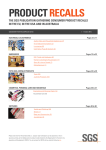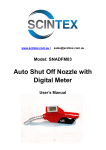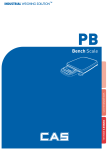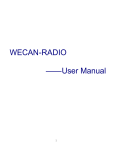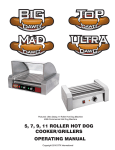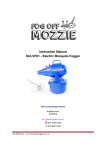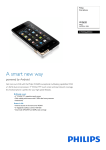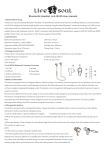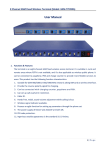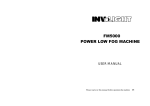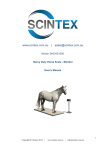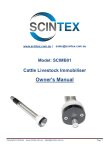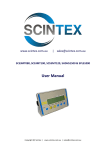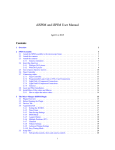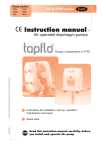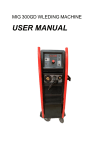Download Drum Barrel Pump
Transcript
A. SAFETY All safety instructions must be observed and followed before use. 1. There are high speed rotating components. Failure to follow the safety instructions may lead to serious injury. All safety instructions must be observed and followed strictly. 2. Before installing and starting the barrel pump the use should have suitable qualifications and is be familiar with this manual. 3. The installation and maintenance must be according to current machinery and electrical standards. 4. The spare parts life time will be limited by wear and corrosion. The failure is affected by operating environment. The user has the responsibility to operate in accordance with regulations. Regular maintenance should be performed regularly. www.scintex.com.au | [email protected] When Using 1. Wear protective clothing, goggles in accordance with safe practice and materials handling. 2. It is prohibited to use plastic or aluminum alloy pump piping and non-explosion proof motors when transferring flammable liquids. 3. For flammable liquids, the earth wire must be installed along with an electrostatic protection device and conductive hose. 4. Make sure the pump pipe is inserted into the liquid completely before using. Make sure all connections are liquid tight. Model: SP240VD90L 240V Drum Pump with Dip Tube 5. Suitable flexible pipe must be used when transferring high temperature liquids. 6. Ensure the pumped liquids temperature, viscosity and density do not exceed the stated upper limits for this pump. 7. Use a suction filter in the pump tube when transfering liquids with impurity or solids. To avoid the blocking, please check and clean regularly. 8. Make sure the pump is under supervision before powering on. Never leave the pump unattended when in use. 9. Do not touch the tube bottom after switching on the pump. The impeller spins at high speed and may lead to equipment damage and personal injury. Make sure the pump tube is operating in the vertical position. Never upend or lay flat after using. Pay attention to residual liquids which may lead to injury or cause environmental damage. B. MACHINE DESCRIPTION MOTOR: AC series motor with overheating protection components, Quick coupling adapter, Automatic positioning coupling and Adjustable speed switch. User’s Manual ATTENTION! • Never leave the pump unattended. •Neverrunthepumpdry. • The pump should not be immersed deeper into the liquid than the outlet connection. C. TECHNICAL DATA C1. Electrical Data PUMP MODEL ELECTRICAL POWER Current Voltage(V) Power (W) Load Speed (RMP) Rated Speed (RMP) AC 230 450 3000~11000 20000 SP240VD90L D. OPERATING CONDITIONS D1. Environmental Conditions Electro-Motor operating environment: -25~40˚C D2. Power Supply Make sure that the supply voltage corresponds to the voltage indicated on the rating plate. ATTENTION! Power from lines with values outside the indicated limits can damage the electrical components. 1 of 4 J. PROBLEMS AND SOLUTIONS E. MOVING AND TRANSPORT Ensure the pump and pump tube are packaged properly for transport. PROBLEM No flow rate or small flow rate F. INSTALLATION Safety Check Make sure that the supply voltage corresponds to the voltage indicated on the rating plate. 7.1 Motor Installation 1. Pump tube check: Make sure every joint has a good seal. 2. Motor Check: Make sure the power cable c and switch are in good condition. Do not put hands near the motor output shaft. 3. Put the motor coupling is directed at the pump tube. Make sure the pump tube head is inserted into the motor head completely. 4. The motor and pump tube position can be adjusted by 360°. Put the pump tube adjusted to the suitable position and lock the nut to finish the installation. It is recommended that the pump discharges away from the motor power cable. 7.2 Start Make sure all the joints are sealed. The tube outlet must be fixed well to avoid pressure leaking. F7. Electrical Connections •Terminalstripboxconsists - ON/OFF switch; of: - Speed regulating knob switch - Speed regulating circuit board • 5M Power cable AC Vibration and noise Pump tube leakage Switch POSSIBLE CAUSE CORRECTIVE ACTION Loss of power source Check power supply Motor failure, Motor Check Outlet closed or blocked Open the outlet valve and check Suction lift too great Short the transportation distance and height Liquid viscosity too high Check the type with supplier Liquids draining out Stop the pump Blocked inlet Clean the inlet Liquids draining out Stop the pump Motor overload Check the liquids viscosity and pump lift Sliding bearing damage Change the sliding bearing and seal ring Coupling wear Change the coupling Seal ring wear Change the seal ring Circuit failure Check the circuit Overuse of the motor, overheating Restart the motor after cooling down protection, electric brush damage Change the electric brush K: DIAGRAM & PARTS LIST Speed regulating circuit board M ATTENTION! IT IS THE INSTALLER’S RESPONSIBILITY TO PERFORM THE ELECTRICAL CONNECTIONS WITH RESPECT TO SAFETY REGULATIONS. G. DAILY USE No. Qty. No. Qty. No. Description 1 Tapping screw 3 9 Lining 1 17 Motor 1 2 Speed control knob 1 10 Speed control circuit board 1 18 Cable 1 3 Switch block 1 11 Motor shell 1 19 Coupler 1 4 Countersunk head tapping screws2 12 Tapping screw 3 20 Bottom cover 1 5 Head cover 1 13 The handle cover 1 21 Flat gasket 3 6 Tapping screw 2 14 Binding post 1 22 Spring washer 3 7 Rotary knob connector 1 15 Wire pressing piece 1 23 Bolt 3 8 Toggle switch 1 16 Cable shield 1 24 Tapping screw 8 Description Description Continuous running may cause motor overheating, the overheating protection system will cut the power automatically. The motor can be restarted again after cooling down by pressing the on/off button. ATTENTION! Thesuggesteddutycycleis2hours.Donotexceedonehourwhentheenvironmenttemperatureismorethan30˚C Please change the electric brush every 250-300hours H. NOISE LEVEL Under normal working conditions the noise emission from all models does not exceed the valve of 80 db at a distance of 1 meter from the electric pump. I. DISPOSING OF CONTAMINATED MATERIALS In the event of maintenance or demolition of the machine, do not disperse contaminated parts into the environment. Refer to local regulations for their proper disposal. 2 of 4 3 of 4 Qty. 1 2 3 6 4 5 7 8 9 10 12 11 13 14 1 15 17 16 18 19 20 21 23 24 4 of 4 22



